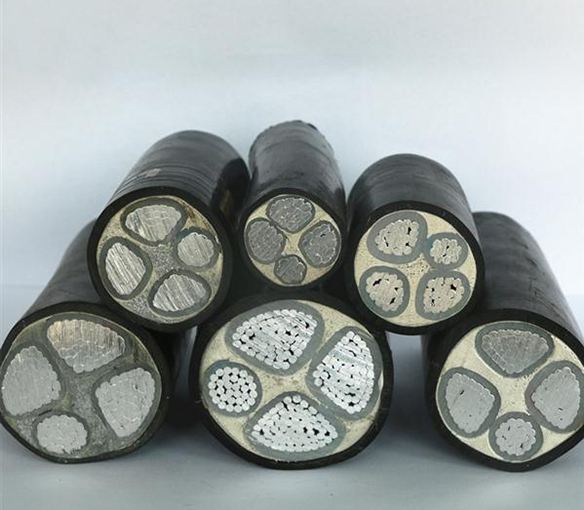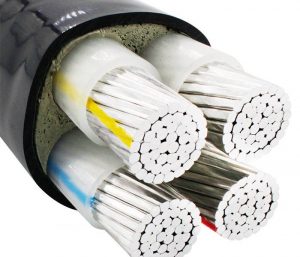At a time when the price of copper, the raw material of cables, remains high and the profit rate of cable manufacturers has dropped sharply, the price of aluminum, which is also the raw material of cables, is far lower than the price of copper. Therefore, the topic of “saving copper with aluminum Alloy” has been hotly debated. Will the performance of new aluminum alloy cables meet the requirements?
Take the mature and common copper-clad aluminum power cable in the market and the wire and cable for electrical equipment as an example for comparison.

a) DC resistivity: the resistivity of copper clad aluminum wire is larger than that of pure copper wire, about 1.5 times that of pure copper wire. When the resistance value is the same (the cross-sectional area is larger than that of copper), the weight of copper clad aluminum wire is about 1 / 2 of that of pure copper wire. According to the skin effect calculation, when the frequency is above 50MHz, the resistivity is the same as that of the copper conductor with the same cross section. In the use of power cables with a frequency of 50Hz, the skin effect and proximity effect of copper conductors are gradually prominent when they are above 150mm2. Meanwhile, due to the failure of equipment power (such as high-frequency furnace, high-power motor, etc.) in industrial and mining enterprises during startup and operation, the energy generating high-order harmonic current will be injected into the power supply system, generating high-order harmonic voltage of corresponding frequency on the impedance of the system, resulting in distortion of the voltage waveform, Increase the loss of the power supply system and increase the conductor heating.
In addition, the cable amplifies the harmonic wave, and generates overvoltage at the joint to damage the cable head. The use of copper-clad aluminum conductors can reduce the AC impedance (resistance) caused by high-order harmonics. In other applications, by increasing the volume of copper in the copper clad aluminum monofilament and taking corresponding technological measures, the copper clad aluminum conductor can meet the DC resistance requirements of the conductor within the upper limit of the outer diameter of the existing conductor of the same specification.
b) The use of copper-clad aluminum conductor can meet the current habits of wire and cable in product selection, design, use, installation and other aspects, which have lasted for many years. It is also beneficial for cable terminal compression and tin welding.
c) Reducing AC resistance: AC resistance is the main basis for current carrying capacity. According to the principle of skin effect, the current per unit area of the surface of a single wire is larger than that of the center of the wire. That is to say, the center of a large cross-section conductor is within the circle area composed of the same conductor, and the current passing through the center is smaller than that of the circumference. Therefore, it is most reasonable and economical to use different metals for the center conductor and the circumference conductor.

In addition, in addition to DC resistance and skin effect, there is also proximity effect. Compared with copper conductor with the same DC resistance, copper-clad aluminum conductor with enlarged cross section shall be used. In a single conductor, aluminum is at the center of the circle and copper is at the outer circle; The enlarged copper-clad aluminum conductor increases the surface area of the conductor due to the increase of the total cross section of the conductor, improves the heat dissipation condition of the cable and increases the heat dissipation area. The thermal conductivity of aluminum is similar to that of copper. Under the same material cost, the AC resistance index is much more economical.
d) It has good corrosion resistance: aluminum is easier to corrode than copper. However, as the copper clad aluminum material has been fully metallized, aluminum is completely covered by copper, and will not be contacted by water and air. It fully achieves the same performance as copper. For aluminum conductors, especially in coastal areas, the chloride ions contained in the salt mist in the atmosphere will condense on the surface of aluminum, which is easy to cause local corrosion around the impurities and defects on the surface, forming holes, cracks and micro cells, and intensifying the corrosion of aluminum conductors.
e) Low cost and light weight: compared with the copper core wire with the same technical index, the copper clad aluminum conductor cable can save more than 40% of the cost. The specific gravity of copper clad aluminum wire is only 37% – 40% of that of pure copper wire, and its length is 2.5 times of that of pure copper wire when the wire diameter and weight are equal.
f) Good solderability: copper clad aluminum wire has the same solderability as pure copper wire because its surface is concentrically coated with a layer of pure copper, which is convenient for production.
